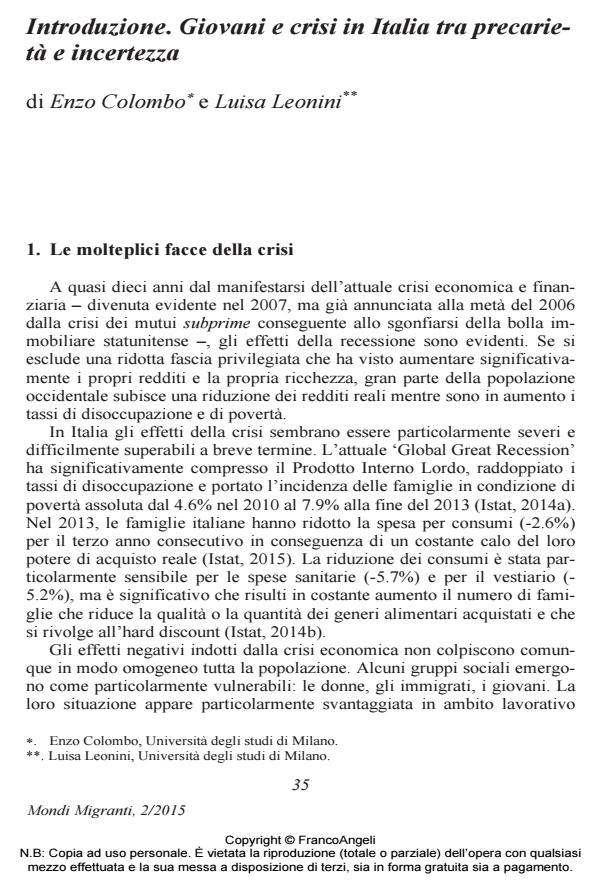Young People and Economic Crisis in Italy: Between Precariousness and Uncertainty
Journal title MONDI MIGRANTI
Author/s Enzo Colombo, Luisa Leonini
Publishing Year 2015 Issue 2015/2 Language Italian
Pages 17 P. 35-51 File size 120 KB
DOI 10.3280/MM2015-002002
DOI is like a bar code for intellectual property: to have more infomation
click here
Below, you can see the article first page
If you want to buy this article in PDF format, you can do it, following the instructions to buy download credits

FrancoAngeli is member of Publishers International Linking Association, Inc (PILA), a not-for-profit association which run the CrossRef service enabling links to and from online scholarly content.
The article shows the complexity of the current economic and financial crisis. It applies an intersectional perspective in order to highlight the different effects the present ‘Global Great Recession’ is having on the lives of young people in Italy. Particular attention is given to the young people’s generation location and the consequences of the specific intertwining of gender, ethnic background and cultural capital. By analyzing the condition of young people within the crisis, it is clear that the traditional 'structural' dimensions (such as gender, class, ethnic background, social and cultural capital, the different geographical location, etc.), although still central in determining the effects of crises in individual lives, do not fully reveal useful if considered in isolation. Intersectional analysis evidences that the specific social location, result of the particular crossing of the different structural dimensions, produces distinct configurations of opportunities and constraints, supporting or hindering individual and collective agency.
Keywords: Generation, Young people, Intersectionality, Economic Crisis, Italy, Cultural capital
- Ambrosini M. (2010). Richiesti e respinti: l'immigrazione in Italia, come e perché: Milano: Il Saggiatore.
- Appadurai A. (1996). Modernity at Large. Minneapolis: University of Minnesota Press.
- Barbieri P. (2011). Italy: no country for young men (and women). In: Blossfeld H.P, Buchholz S., Hofäcker D. e Kolb K., a cura di, cit.: 108-148.
- Barbieri P. e Scherer S. (2009). Labour Market Flexibilization and its Consequences in Italy. European Sociological Review, 25, 6: 677-692.
- Blossfeld H.P, Buchholz S., Hofäcker D. e Kolb K., a cura di (2011). Globalized Labour Markets and Social Inequality in Europe. Basingstoke: Palgrave Mac-Millan.
- Bonifazi C. e Marini C. (2011). Il lavoro degli stranieri in Italia in tempo di crisi. L’economia dell’immigrazione, 1: 1-5.
- Cappellari L. e Lucifora C., a cura di (2014). Economia della popolazione: disuguaglianza, famiglia e migrazioni. Milano: Vita e Pensiero.
- Castells M. (1996). The Rise of the Network Society. Oxford: Blackwell.
- Castles S. (2012). Cosmopolitanism and freedom? Lessons of the global economic crisis. Ethnic and Racial Studies, 35, 11: 1843-1852.
- Colombo E. e Rebughini P. (2012). Children of immigrants in a globalized world. A generational experience. Basingstoke: Palgrave.
- Colombo E. e Rebughini P. (2015). Italian young people coping with the consequences of economic crisis: an intersectional analysis. Oñati Socio-Legal Series, 5, in corso di stampa.
- Cottini E. e Vitali A. (2014). I giovani e la Grande Recessione. In: Cappellari L. e Lucifora C., a cura di. cit..
- Direzione generale dell’Immigrazione e delle Politiche di Integrazione (2014). Quarto rapporto annuale. Gli immigrati nel mercato del lavoro in Italia. Roma.
- Edmunds J.E, Turner B.S. (2002). Generations, Culture and Society. London: Open University Press.
- Fullin G., Reyneri E. (2013). Gli immigrati in un mercato del lavoro in crisi: il caso italiano in prospettiva comparata. Mondi Migranti, 1: 21-36.
- Gallino L. (2012). La lotta di classe dopo la lotta di classe. Laterza, Roma-Bari.
- Istat (2015). Reddito e risparmio delle famiglie e profitti delle società. III Trimestre 2014, Notizie Flash, 9 gennaio 2015,Tavole QSA – 2014Q3. Roma
- Istat (2014a). La povertà in Italia. Anno 2013, Statistiche Report, 14 luglio 2014. Roma.
- Istat (2014b). I consumi delle famiglie. Anno 2013, Statistiche Report, 8 luglio 2014. Roma
- Istat (2014c). Rapporto annuale del paese 2014. Roma.
- Istat (2013). Rapporto annuale del paese 2013. Roma.
- Leonini L. e Rebughini P., a cura di (2010). Legami di nuova generazione. Bologna: il Mulino.
- Mannheim K. (1928). Das Problem der Generationen. Kölner Vierteljahres Hefte für Soziologie, VII: 157-185, 309-330 (tr. it.: “Il problema delle generazioni”, in Sociologia della conoscenza, Bari 1974, pp. 323-371).
- Modena F., Rondinelli C. e Sabatini F. (2014). Economic insecurity and fertility intentions; the case of Italy. The review of income and wealth, Supplement Issues, 60: S233-S255.
- Sassen S. (2000). New frontiers facing urban sociology at the Millennium. The British Journal of Sociology. 51, 1: 143-159.
- Woodman D. e Wyn J. (2014). Youth and Generation. Rethinking Change and Inequality in the Lives of Young People. London: Sage.
Enzo Colombo, Luisa Leonini, Introduzione. Giovani e crisi in Italia tra precarietà e incertezza in "MONDI MIGRANTI" 2/2015, pp 35-51, DOI: 10.3280/MM2015-002002